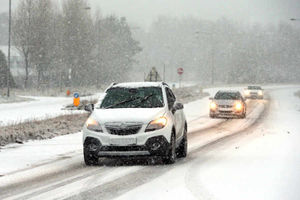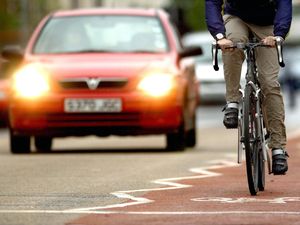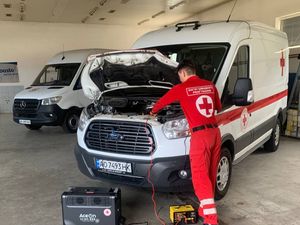Gritters hitting Shropshire roads as snow batters Britain
Gritters were set to hit the roads again in Shropshire tonight with snow forecast to hit the Midlands from 3pm.

In the Midlands today cloud, rain and hill snow is set to move up from the west. Rain may turn to snow to some lower levels this afternoon, most likely in the south of the region.
The Met Office has issued a yellow warning of snow for Shropshire on Friday. It says further showers of snow, sleet and hail will continue across parts of the UK.
Heavy snow was lying across Scotland, Northern Ireland and parts of England by this morning.
London's Heathrow Airport said a combination of snow and windy weather conditions had impacted on flights.
A spokesman said: "There have been a total of 80 flights cancelled for Heathrow Airport."
The Met Office had issued yellow "be aware" warnings of wind and snow for Scotland, warning of gusts of up to 60mph in places and 4in (10cm) to 8in (20cm) of snow on higher.
The warnings also extend to northern parts of England as well as Wales and Northern Ireland, where thick snow blanketed Coleraine and Ballymena.
The weather has affected ferry services, with Caledonian MacBrayne warning "heavy disruptions" are expected.
Northlink ferries and Orkney Ferries also warned disruption was likely due to the weather.
The Met Office described the weather as a "real taste of winter" caused by a p olar airmass, which originated over northern Canada, spreading south across the UK.
The Forth Road Bridge - which connects Edinburgh and Fife - is open again after it was closed all of Wednesday when a lorry was blown over and damaged the central reservation.
Paul Gundersen, chief meteorologist at the Met Office, said the heaviest and most frequent snow showers are likely across northern and western Scotland, Northern Ireland and around Irish Sea coasts, but eastern coasts will also be affected in the coming days.
"Most northern areas are very likely to see snow showers at times over the next few days but the situation over the southern half of England is more complicated," Mr Gundersen said.
"Southern counties of England and Wales can expect a cold and wet day with some heavy rain on Thursday, but there's an increasing chance this will turn to sleet or snow, especially over hills, during the afternoon and evening.
"There is a chance of snow settling, bringing disruption to transport during the evening rush-hour and possibly interruptions to power supplies - this more likely across East Anglia and south-east England.
"As skies clear on Thursday night, it is likely to become icy in many areas.
"Forecasting snow is always challenging and there's often a fine line between whether it will rain or snow in a particular location depending on slight changes in air temperature."
It follows a wet and windy day on Wednesday for Scotland and the north of England which left homes without power and major travel disruption.
A gust of 93mph was recorded at High Bradfield in South Yorkshire and 82mph at Emley Moor in West Yorkshire.
Engineers worked to reconnect thousands of homes in Yorkshire, Cumbria, Cheshire and the north of Scotland and will be on stand-by throughout Thursday.
The Energy Networks Association has reminded people they can call 105 - the new, free national phone line - if the weather damages their local power network and affects their electricity supply.
West Mercia Police snowy weather driving advice for motorists:
With snow forecast over the coming days, the best advice when severe weather hits is to stay off the road.
If people do choose to drive, however, they are advised to ensure they are prepared for the conditions.
When temperatures plummet - potentially resulting in heavy frost and icy patches on roads - ice, fog, tiredness, lack of concentration and unusual journey patterns are all factors that can possibly lead to a collision.
Police are asking motorists to drive safely, within the law, and follow the advice below:
Plan your journey
• Ask yourself - is your journey absolutely essential?
• Clear your windows and mirrors before you set out and carry a windscreen scraper and de-icer.
• Check your vehicle is well maintained and serviced.
• Always keep the lights, windows and mirrors clean and free from ice, snow and condensation - it is illegal to drive with obscured vision.
• Keep your battery fully charged.
• Make sure you have sufficient fuel for your journey. Keep the fuel tank topped up.
• Add anti-freeze to the radiator and winter additive to the windscreen washer bottle(s).
• Keep windscreen washer fluid topped up as windscreens quickly become dirty from traffic spray and salt on the roads.
• Check that tyres have plenty of tread depth and are maintained at the correct pressure.
• Keep a torch and spare batteries in your glove box.
• If the weather deteriorates ensure you are equipped to deal with a breakdown and the cold/adverse weather.
• Wear comfortable shoes, keep warm clothing, a blanket and sensible footwear such as boots in the car in case you get stuck or need to get out.
• Carry a thermos flask and high-energy snacks, such as chocolate, so you can have a hot drink and something to eat.
• If your vehicle breaks down and you have to leave your car to get help, make sure you wait a safe distance away from the vehicle.
• Take a mobile telephone with you and make sure it is fully charged. Carry a mobile charger in the car. Remember do not use your mobile phone whilst driving. Pull over, stop the engine and remove keys from the ignition before using your mobile.
• Always drive within the speed limit and don't rush or take risks - it is better to be late than never to arrive at all.
Adjust your driving to the conditions
• Hail, snow and rain reduce visibility - use dipped headlights and reduce your speed.
• Remember, when temperatures fail to raise much above freezing point during the day, many roads - particularly in dips or where there are high walls or hedges - will remain covered in frost.
• Never assume the road has been gritted. Be prepared for some isolated sections of road and certain gradients to remain icy when more exposed sections have thawed.
• Be aware that different road surfaces react differently to severe weather - hail, snow and rain all reduce your visibility.
• Drive with extra care, adjusting your driving to the weather conditions and allowing extra room/time to slow down and stop.
When roads are icy or slushy
• It can take ten times longer to stop in icy conditions than on a dry road. Drive slowly, allowing extra room to slow down and stop.
• Use the highest gear possible to avoid wheel spin. Manoeuvre gently, avoiding harsh braking and acceleration.
• To brake on ice or snow without locking your wheels, get into a low gear earlier than normal, allow your speed to fall and use the brake pedal gently.
• If you start to skid, ease off the accelerator but do not brake suddenly.
• Drive with extra caution on cold frosty days even along roads you use everyday and think you know well. There may be a patch of water that has iced over or an unexpected covering of frost.
Salting vehicles
• Salting vehicles travel at speeds of up to 40mph spreading salt across all lanes of the carriageway. Drivers are advised to maintain a safe distance behind them. Do not attempt to overtake. Take care when travelling behind winter service vehicles.
Snow ploughing
• Snow ploughing can throw up irregular amounts of snow that may be a hazard to vehicles. Drivers are advised to maintain a safe distance behind vehicles and do not attempt to overtake. Drivers of vehicles such as salt spreaders and snow ploughs take all reasonable precautions to protect other road users from harm. Take care around winter maintenance vehicles.
Surface Water
• If you can avoid it, it's best not to drive through lying surface water as you might flood your engine.
• To avoid the risk of flooding your engine and/or becoming stranded, try and find an alternative route and avoid driving through the flooded area. If in doubt, don't drive through the flooded area - yours and other people's safety is most important.
• If you do have to drive through flooded roads, use first gear. Move forward immediately to avoid stalling the engine. Keep your revs high and depress your clutch when you need to.
• Test your brakes after passing through the water. If they work then you can drive on at your usual speed providing it's safe to do so.
• Know your vehicle's capabilities; don't attempt to drive through deep water and risk getting stuck.
Following this advice will help protect yourself, your vehicle(s) and others from harm while driving on our roads.
Visit thinkroadsafety.gov.uk for more road safety advice




